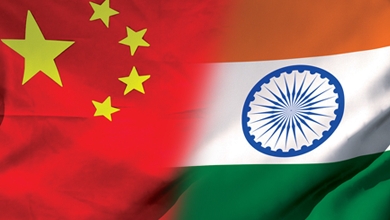India and China Dispute: The World’s Longest Unmarked Border

Incongruous, deadly, bizarre. Two nuclear powers engaging in a fatal skirmish over a piece of territory with no economic resources, using rocks and clubs with protruding nails. A stone-age fight in the nuclear era.
Einstein said he did not know what exact weapons would be used in a war with nuclear powers. But he knew the weapons of mass destruction that would be used in the one after that. Sticks and stones. Few envisioned nuclear-weapon states using such primitive weapons before launching Armageddon.
India and China dispute the world’s longest unmarked border. There has been conflict. War in 1962, easily won by China, skirmishes since then, no bullets fired since a deadly clash in 1975 when an unofficial agreement not to use firearms in the border area was reached. It was considered that no large-scale conflict could emerge from a stone-age fight. Scrap that.
The Sino-Indian border is a hotbed of tension. According to the Indian government, the Chinese military went into Indian territory 1,025 times between 2016 and 2018. Trouble is this is easily disputed as the area is not officially marked. So what is India’s or China’s territory?
Most of these clashes apparently emerge from differing assessments of the location of the so-called Line of Actual Control — the de facto international border.
The military superpowers have been arguing, and fighting, for decades over territory in the high-altitude, largely uninhabited region.
Facing off at 4,600 meters high along a 3,440km border could be described as the height of folly.
It comes at a price. On Monday at least 20 Indian soldiers were killed in the Galwan Valley in the disputed Ladakh region.
The loss of life, believed to be the first in 45 years at the border, raises the stakes considerably.
Indian officials spoke of fighting with bare hands, clubs and stones. There were reports of Chinese casualties, but no official confirmation. Both countries accuse the other of building up infrastructure and stoking tension.
There have been agreements. But times have changed.
In 1988 the two countries were roughly equal on the economic stage. According to the World Bank, India’s gross domestic product was about $300 billion compared with China’s $312 billion that year. New Delhi’s defense budget was $10.6 billion. Beijing’s official budget was in the region of $11 billion.
A state of parity. That was then. Now China has risen, so has India, but China to greater heights. China’s GDP, north of $13 trillion, dwarfs India’s $2.7 trillion. Same story on defense spending. Beijing, again according to its official budget, splashed out $261 billion on defense expenditure in 2019. India spent about $71 billion. India has risen as an economy and a global power in the past three decades, but shrunk markedly relative to China.
China has also become more belligerent. Hide your light under a bushel, Deng Xiaoping’s mantra, has been superseded by Xi Jinping’s more aggressive foreign policy.
From island-building in the South China Sea to its shriek post-Covid-19 outbreak diplomacy, Beijing is clearly adopting a different approach.
But that is not the only difference. The Unites States under Trump is shedding its authority. Neither China or India expects or even wants US involvement and the US clearly does not want to be involved. A fatal clash between two nuclear powers and Washington does nothing. No envoys dispatched. No sense of urgency from the White House. No demand for a cooling-down period. No leadership. Europe too seems to have lost its voice. From the East, the West looks shallow, a busted flush.
It may be that both India and China will settle their dispute amicably and quickly cool tensions. But it would be foolhardy, and dangerous, to dismiss any other alternative as unthinkable.
*
Note to readers: please click the share buttons above or below. Forward this article to your email lists. Crosspost on your blog site, internet forums. etc.
Tom Clifford is a renowned journalist currently based in Beijing.


